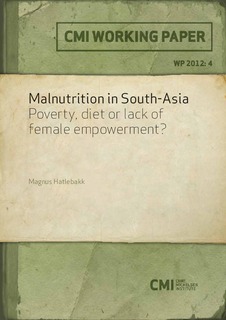| dc.contributor.author | Hatlebakk, Magnus | |
| dc.date.accessioned | 2018-01-04T08:18:45Z | |
| dc.date.available | 2018-01-04T08:18:45Z | |
| dc.date.issued | 2012-03-21 | |
| dc.identifier | oai:www.cmi.no:4406 | |
| dc.identifier.citation | Bergen: Chr. Michelsen Institute (CMI Working Paper WP 2012:4) 18 p. | |
| dc.identifier.isbn | 978-82-8062-432-1 | |
| dc.identifier.issn | 0804-3639 | |
| dc.identifier.uri | http://hdl.handle.net/11250/2474908 | |
| dc.description.abstract | Despite economic growth, and a reduction in poverty, malnutrition is still rampant in South-Asia. This indicates that non-economic factors are important, and we use a nation-wide survey from Nepal to identify factors that may explain why small children are stunted. In contrast to designated studies of child nutrition we do not have information on individual food intake, but we demonstrate that analysis of large sample surveys is a good supplement to designated studies, with the main benefit being that findings are nationally representative. We find that pulses are critical for child growth, and that boys are more often malnourished, maybe because they are expected to take other food than breast milk. Furthermore we find that girls are more likely malnourished if they have many older brothers, and we find that female empowerment improves child nutrition. | |
| dc.language.iso | eng | |
| dc.publisher | Chr. Michelsen Institute | |
| dc.relation | CMI Working Paper | |
| dc.relation | WP 2012:4 | |
| dc.relation.ispartof | CMI Working Paper | |
| dc.relation.ispartofseries | CMI Working Paper WP 2012:4 | |
| dc.relation.uri | https://www.cmi.no/publications/4406-malnutrition-in-south-asia-poverty | |
| dc.subject | Female Autonomy | |
| dc.subject | Stunting | |
| dc.subject | Intra-Household Allocation | |
| dc.subject | Nepal | |
| dc.title | Malnutrition in South-Asia. Poverty, diet or lack of female empowerment? | |
| dc.type | Working paper | |
